Deck Aviation. Part of 1. USA
Multipurpose aircraft carriers with an aircraft wing based on them (75-85 aircraft) are the core of carrier-assault groups (AUG) and aircraft-carrier strike connections (AUS), which are part of the US Navy’s operational fleets in the Atlantic, Pacific and Indian oceans and the Mediterranean. In the XXI century, ships of this class will remain the most important means of the US Navy to gain and maintain dominance at sea, as well as air superiority over land theaters of military operations.
USS Nimitz aircraft carrier (CVN-68)
It is these huge ships and aviation for various purposes, based on them, are the main striking force fleet. Formally, ballistic missile submarines outperform aircraft carriers in destructive potential. But they are certainly weapons "Doomsday". And they cannot be used in the “guidance of the world order” in the wars for resources. Virtually none of the conflicts involving the United States was not without the use of aircraft carriers, and in some of them they played a major role.
Satellite image of Google Earth: US Navy aircraft carrier "George Washington" while stationary in Singapore
As part of the US Navy on 15 August 2012, the 10 nuclear multipurpose aircraft carriers of the Nimitz type, the 8 universal amphibious assault ships of the WOSP type, the 3 amphibious helicopter dock of the Austin type, 5 of the San Antonio type were stationed. From the Nimitz-type aircraft carriers, deck aircraft take off using a steam or electromagnetic catapult, and landing thanks to a cable arresting vehicle. Helicopters and amphibious assault ships are capable of being based on vertical takeoff and landing of the AV-8B Harrier II Marine Corps (USMC) USA.
The number of carrier-based aviation of the US Navy, according to official data, is 1117 of the aircraft and helicopters of the main forces and up to 70 in reserve. In addition to the actual carrier-based aviation, the USMC has 182 fighter-attack aircraft and 24 electronic warfare aircraft (EW), as well as 48 aircraft in reserve. For comparison, in the Russian Air Force on 1 on April 2011, there were 670 aircraft in fighter aircraft and 557 in front-line aviation (including those in reserve).
Universal landing ship USS Wasp (LHD-1)
The main strike force of deck aviation are airplanes: F / A-18E / F Super Hornet (Eng. Boeing F / A-18E / F Super Hornet) - American carrier-based fighter-bomber and attack aircraft.
This is a deep redesign of the F / A-18 fighter project. The Super Hornet is pretty much a new aircraft. The wingspan is 20% more, the mass of an empty aircraft is 3200kg, the maximum take-off weight is 6800 kg more compared to the original model. In terms of fuel reserves, the new vehicle exceeds the Hornet by 33%, which made it possible to increase the combat radius by 41% and the flight duration by 50%. On the mass of an empty Super Hornet, approximately 5000 kg is lighter than the F-14 Tomcat fighter, while at the same time, according to the characteristics of the payload mass and flight range, the Super Hornet approaches F-14, although it does not exceed its predecessor. On the F / A-18E / F Super Hornet, two General Electric F414 engines are installed, the F414 TRDDF power is increased by 35% relative to the F404-400 engine used on F / A-18 / F fighter-bombers. The radio-electronic complex includes a multipurpose pulse-Doppler Hughes radar AN / APG-73 with a maximum detection range of fighter-class air targets of the order of 80 km. She is able to accompany "on the aisle" to 10 targets and simultaneously direct four AMRAAM SDs with active radar homing at the same time. The station, equipped with a slot antenna array with mechanical scanning in the horizontal plane and electronic - in the vertical, is a further development of the Hughes radar AN / APG-65. The F / A-18E / F cockpit equipment has been significantly improved compared to F / A-18C / D. The EEC IDECM complex includes the Hughes AN / ALR-67 (V) 3 radar warning station, the AN / ALE-50 towed target, which is located under the fuselage and also four blocks of the IR trap spread and dipole reflectors "Trakor" AN / ALE-47.
Armament fighter F / A-18E / F is placed on the 11 nodes external suspension. The air-to-air UR includes the AIM-9М Sidewinder short-range missiles (up to 12 units), the medium-range UR AIM-7М Sparrow (up to eight units) or AIM-120 AMRAAM (up to 12). There is a built-in six-barrel 20-mm gun M61А1.
For the destruction of ground (surface) targets can be used missiles AGM-65 "Maverick" (six units), AGM-88 HARM (six), AGM-84H SLAM (four) or AGM-84A "Harpoon" (four). The aircraft can carry planning aircraft bombs AGM-154 JSOW (six), KDB JDAM GBU-32 (caliber 900 kg, four units) or GBU-32 (450 kg, six units), as well as a CAB with laser homing of the "Paveway" type II / III (11 units). After the cancellation of the F-14 Tomcat, the aircraft was assigned the task of air defense and missile defense of aircraft carrier connections. The total mass of the F-18E / F fuel with five outboard tanks is 14 t, which allows it to be used as a tanker aircraft instead of the KA-6.
EA-18G Growler(English Boeing EA-18G Growler) -EW plane. Created to replace the Grumman EA-6 "Proler".
First flight 2006 year. It is in mass production, on the 2012 year for the US Navy 66 was delivered from 114 planned aircraft. Fighting radius - 1575km, with 2 x AIM-120, 2xAGM-88,3хALQ-99, 2 PTB (for 2100 fuel).
F-35 "Lightning" II (Eng. Lockheed Martin F-35 Lightning II, Russian. "Lockheed-Martin" F-35 "Lightning" II) - a family of promising, unobtrusive fifth-generation fighter-bombers, developed by the American company Lockheed Martin Aeronautics Company, in three versions: option for the US Air Force (ground fighter), for the USMC and the British Navy (fighter with a short takeoff and vertical landing), and for the US Navy (deck fighter).
The choice of the F-35 design was made in 2001 year as a result of a JSF (JointStrike Fighter, single strike fighter) competition between Boeing (model X-32) and Lockheed Martin (model X-35). The program provided for the creation of a single fighter model for the Air Force, Navy and Marine Corps with the possibility of vertical and short takeoff and landing to replace the F-16, A-10, F / A-18, AV-8B. The British Sea Harrier will also be replaced.
The F-35B version of the F-35B short takeoff and vertical landing fighter, designed for stationing on aircraft carriers that are not equipped with catapults (light aircraft carriers, large landing craft), is capable of vertical takeoff. To do this, the F-90B engine nozzle is turned downwards by XNUMX °, and behind the pilot's cockpit a vertically mounted fan connected to the main engine creates a lifting pull.
During a cruise flight, the lift fan stops and closes with flaps. Yaw control during the hang provides additional engine nozzles that can move left and right. For roll control in each wing of the wing there are additional nozzles that are powered by the main engine. Pitch varies raznotyag lifting fan and engine. The position of the aircraft during a freeze is fully controlled by the on-board computer. This allows you to significantly simplify the management of the aircraft in comparison with analogues. In addition, in an emergency, the computer is able to make a decision about ejection much earlier than a person.
Vertical thrust allows the F-35B with a low combat load and incomplete fuel tanks to take off and land vertically. With a greater load of vertical thrust for take-off is not enough and take-off is carried out with a small run-up (the so-called shortened take-off). Also, with low mileage, can be carried out and landing. In practice, due to the fuel consumption in flight, the take-off weight of the aircraft turns out to be significantly higher than the landing. Therefore, as a rule, the take-off is shortened and the landing is vertical. The design of the F-35B is very similar to the Yak-141. This is due to the collaboration of Lockheed Martin and Yakovlev Design Bureau in 90. However, it has significant differences. The Yak-141 used two turbojet engines to create vertical thrust. The use of a lifting fan on the F-35B reduced the thrust losses of the main engine from the entry of combustion products into the air intake and reduced the temperature loads on the surface of the landing pad. But the designs of both aircraft have common drawbacks: during normal flight, the aircraft carries “dead weight” in the form of lifting units. They also take a significant amount under the fuselage, where fuel tanks are usually placed. The result of such design decisions is a significant reduction in flight range (F-35B of the entire 35-x series has the shortest flight range).
EA-6 Prowler (Eng. Grumman EA-6 Prowler, “Marauder”) —The US Navy deckship aircraft designed to conduct electronic reconnaissance and electronic warfare (DER and EW).
The base for the creation of the EA-6B Prowler was another Grumman aircraft — the A-6 Intruder ground attack aircraft, which had been removed from service today. When creating a car, the fuselage length was increased, due to which the crew was increased. The crew consists of four people - a pilot and three officers operating EW systems. When the Prowler was put into service, a tactical jamming system was installed on it, capable of jamming five radar signals at once. At the end of the 1980's, the “Crawlers” of the EA-6B variant were enhanced by the ADVCAP program in two ways. First of all, a new AN / ALE-39 jamming station, a passive tracking system and signal suppression, was installed. The avionics modernization program has resulted in equipping the EA-6B machines with new liquid crystal indicators, a more powerful radar, digital autopilot and AN / ALQ-19 communication system.
Improving the flight characteristics of the aircraft occurred during the implementation of the VEP program (technical modernization program). The aircraft is still in use, but EA-18G Growler is gradually being replaced.
E-2 "Hokai" (Eng. Grumman E-2 Hawkeye) —American deck-based radar detection aircraft.
Used in a number of armed conflicts. With the 1970's, the main modification is the E-2C; it is planned to replace it with E-2D "Advance Hawk".
DRLO E-2C aircraft provides maximum target detection at a distance of about 540 km (airplanes) and 258 km (cruise missiles).
The Hokai can also monitor surface targets. The information received is transmitted to the information operations center located on the flagship of the aircraft carrier, as well as to the fighters patrolling the airspace (combat air patrols). The E-2C, which is used as a command post, is capable of targeting fighters, executing early warning of the appearance of enemy aircraft, and controlling escort fighters.
C-2 Greyhound (eng. Grumman C-2 Greyhound) is a medium-range deck tactical transport aircraft. Developed by the American firm Grumman based on the DRLO E-2A Hawkeye aircraft for supplying aircraft carrier connections. Adopted by the US Navy in December 1966 year.
The fuselage is all-metal, oval cross-section, with a hermetic cabin. The wing is of all-metal construction, the wing end parts of 7,8 m length can be folded in the parking lot, turning back and fixed along the fuselage. The aircraft has a cargo cabin with dimensions 8.38 x 2.23 x 1.68 m, and aft cargo door with an integrated ramp - ramp 2.29 wide and 1.98 height m. Total 58 pcs.
AV-8B Harrier II (Eng. McDonnell Douglas AV-8B Harrier II) - American attack aircraft vertical takeoff and landing. AV-8B "Harrier" II is a development of the early modification of AV-8A "Harrier". Slightly increased engine power and a half times the capacity of the fuel tanks, which allowed a third to increase the radius of action. It is in service with the USMC.
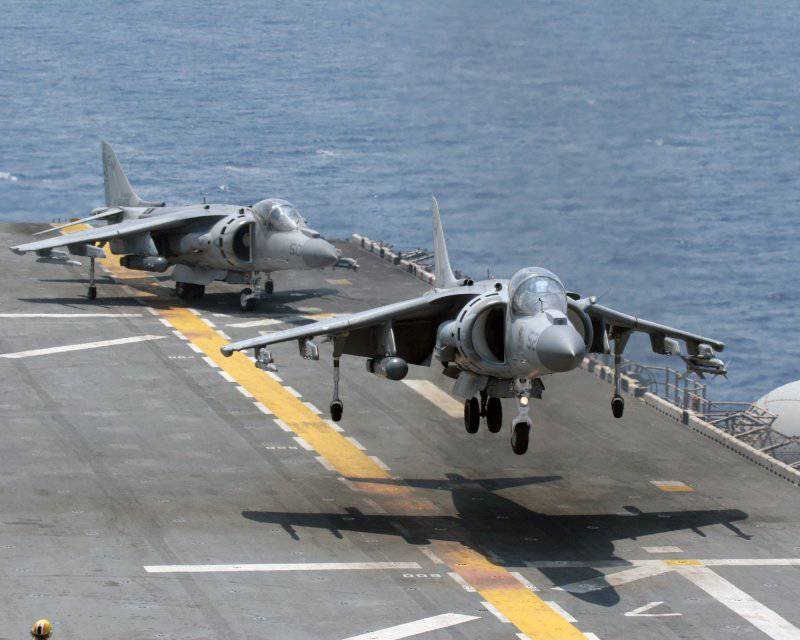
Operated on amphibious assault helicopters and amphibious assault ships.
The AV-8B Harrier II has one up-and-over thrusting engine for a Rolls-Royce Pegasus 11-21 (which in the United States is designated F402-RR-406) with a deflection thrust vector. This engine differs from the previous variants in increased take-off load. Used on the aircraft AV-8B "Harrier" II modern electronic equipment allows the aircraft to perform a wide range of tasks. In developing the cockpit, McDonnell-Douglas widely used the experience of designing the cockpit of the F-15 and F / A-18 aircraft. Aircraft AV-8B "Harrier" II is designed to conduct military operations in good weather, day and night, and has sufficient maneuverability to move away from air defense fighters.
The main tasks of the VTOL aircraft in the USCM are all types of air attacks: bombing from horizontal flight, diving and diving, diving, delivery of conventional and cluster bombs, laser-guided bombs, special bombs, and air-to-surface guided missiles Nur The AV-8B has, like all previous Harrier aircraft, two under-vent nodes for the suspension of cannon containers. For firing at air and ground targets for the AV-8B, one five-barreled General Electric GAU-12 / U gun with a caliber of 25 mm was selected; ammunition 300 shells.
The gun itself is located in the left container, and in the right is its ammunition in a multilayer tape store. The weight of the entire system with 558 ammunition kg. Between the nodes for the suspension of containers of the cannon system there is another central unit for placing loads weighing up to 258 kg: these can be either bombs, or a container with radio-resistance system, or photo reconnaissance equipment.
Despite the planned replacement of the AV-8B with an F-35 family of aircraft, the United States International Law Commission purchased an additional batch of these aircraft in the UK to replace those that were being written off.
A special place is occupied by the class of unmanned aerial vehicles (UAVs) that has been rapidly progressing recently. In the interests of the US Navy, several models have been developed and are being tested. In particular, the “flying wing” scheme X-47B from Northrop Grumman delivered 28 November 2012g. on the aircraft carrier "Harry Truman" for testing. These aircraft, made with elements of technology of small radar visibility, are planned to be used for reconnaissance, target designation, search for submarines, and performance of percussion tasks.
General characteristics:
Length: 11,63 m
Swipe: 18,92 m
Height: 3,10 m
Empty weight: 6 350 kg
Maximum take-off weight: 20 215 kg
Weight payload 2000 kg
Engine: Pratt & Whitney F100-220 turbofan, 8074kg thrust (79,1 kN)
Cruising speed: 0,45 M
Distance: 3889 km
Ceiling: 12 190 m
Armament: 2 x JDAM (kg 905 each)
Sensors: EO / IR / SAR / GMTI / ESM / IO
In the carrier-based aviation of the US Navy, in addition to airplanes, various deck-based helicopters are used. They are used for reconnaissance, disembarkation and fire support of assault forces, search and rescue operations, anti-submarine warfare, etc.
UH-1Y "Venom"(eng. Bell UH-1Y "Venom) - the newest multi-purpose helicopter of Bell Helicopter Textron based on the UH-1N, designed for USMC.
It is a deep modification of the famous "Huey" of the Vietnam War. The helicopter is equipped with a four-blade main rotor made of composite materials, the 2 GTE General Electric T700-GE-401, the fuselage size has been increased for additional avionics, a new avionics kit including GPS and digital mapping system are installed, new systems of passive and active radio engineering countermeasure are installed. Significantly expanded the range of weapons used. Compared with the deck modification of the helicopter HH-60H "Black Hawk", is a much more compact and lightweight machine, which is especially valuable in cramped ship-based conditions.
Marine attack corps based helicopters based on universal landing ships are intended for assault fire support. AN-1W "Cynep Cobra"(Eng. Bell AH-1 Super Cobra) —A modernized version of the AN-1T "Sea Cobra" helicopter.
It has good tactical and technical characteristics, greater reliability, survivability and quite powerful weapons (due to equipping two more economical GTE T700-GE-401 with a total power of 3400 hp, which exceeds the power of the AN-A helicopter at 1300 hp 1T "Sea Cobra"). The Super Cobra can carry weapons in the following versions: eight Hellfire or Toy types of anti-tank guided missiles, four launchers, each with nineteen 70-mm or four 127-mm unguided missiles, a turret at the bottom of the fuselage with 20-mm cannon and one gun of the same caliber in containers on the underwing pylons. In addition, for the first time abroad, this helicopter is armed with AIM-9 air-to-air Sidewinder missiles or Stinger guided missiles to fight enemy helicopters.
The improvement of the helicopter’s weapon control system and the development of night-vision equipment for it continue.
This helicopter is inferior in its characteristics "Apache", but is used in the fleet again due to its smaller mass and compactness.
Heavy three-engine multipurpose helicopters CH-53D "C.Stelen" (eng, Sikorsky CH-53 Sea Stallion), MH-53E are used for transferring manpower and heavy weapons from amphibious ships, as tankers and towers for trawls.
In 2012, the USCM remains the largest CH-53 operator in the world, and the Marine Corps has 15X CH-53E and 36 CH-53D.
CH-53D to be replaced by the convertible plane MM-22 Osprey.
As a platform for machines for various purposes apply SH-60 "Sea Hawk" (eng. Sikorsky SH-60 Sea Hawk) - American multi-purpose helicopter. The SH-60 was developed on the basis of the UH-60 helicopter in accordance with the US Navy's LAMPS Mk.3 competition program (Light Airborne Multipurpose System - light aviation multi-purpose system) for operation from warships.
The first flight of the helicopter took place in the 1979 year and was adopted by the US Navy in the 1984 year.
SH-60F Ocean Hawk - Deck antisubmarine helicopter for carrying out operations to cover aircraft carriers within 50km radius.
HH-60H Seahawk - Deck search and rescue helicopter
for the US Navy.
MH-60R Seahawk - anti-submarine helicopter with lowered gas,
development of SN-60B and SN-60F. Combat load: up to 3 torpedoes Mk46 or Mk50 Barracuda or up to 3 PCR AGM-119B Penguin or up to 4 AGM-114 Hellfire.
MH-60G Pave Hawk - a multi-purpose helicopter for special operations forces, created by the American company Sikorsky Aircraft based on the UH-60 Black Hawk multi-purpose helicopter.
The helicopter is designed for inconspicuous deep penetration deep into enemy territory day or night and in any weather for the delivery, removal and supply of special operations forces. Another task of the helicopter is the search and rescue of combat groups.
One of the most interesting aircraft used in the US Navy is the American helicopter-plane (convertiplane), which has no analogues in other countries. V-22 Osprey(English Bell V-22 Osprey).
It combines the quality of a helicopter (the possibility of vertical takeoff and landing), efficiency and higher speed of flight, like an airplane. V-22 has a flight speed twice as high as that of any helicopter and is capable of carrying a payload three times greater than the CH-46 helicopter. The V-22 is five times as long as the CH-46 for which it is intended to be replaced.
The tactical radius of the VTOL "Osprey" is 648 km, which eliminates the basing of convertiplanes in the immediate vicinity of the front line or "hot spots". A perfect complex of airborne radar and laser systems for detecting and identifying targets posing a threat to the convertoplan is installed on the machine.
According to the test results, a conclusion was made about the adequacy of the onboard defense complex of the V-22 convertoplone, and a recommendation was issued to install the Block B convertiplane of the 240 caliber 7,62 defensive machinegun on the rear ramp. In March, 2008 was signed a contract to build an XVUMX MV-141 and 22 CV-26 XVUMX for five years.
Helicopter-type drone RQ-8A Fire Scout - developed by Northrop Grumman. The first flight made in 2002 year. The RQ-8A can fly for about eight hours at a speed exceeding 230 km / h. He is able to take off and land on his own. It is believed that the potential of "Fire Scout" allows you to replace the whole ship of the Coast Guard. Its further development is the MQ-8В Fire Scout. It is the MQ-8B Fire Scout modification that will become the main unmanned aerial vehicle for the United States Navy.
In total, it was planned to purchase 192 units to provide new ships. drones helicopter type MQ-8B.
The equipment of the drone includes the following devices: optical scanners, infrared scanners, a laser rangefinder, and possible armament - Hellfire missiles.
Sources:
http://ru.zero.wikipedia.org/wiki/Военно-морские_силы_США
http://www.modernarmy.ru/article/73
http://ru.wikipedia.org/wiki/Авиация_ВМС_США
http://topwar.ru/8027-morskaya-pehota-ssha.html
http://army-news.ru/2012/01/o-potenciale-boevoj-aviacii-ssha-i-nato-chast-1/
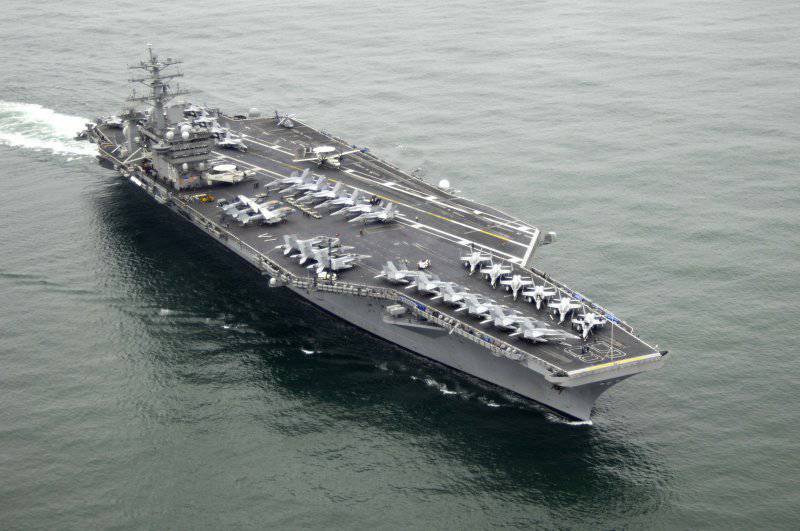
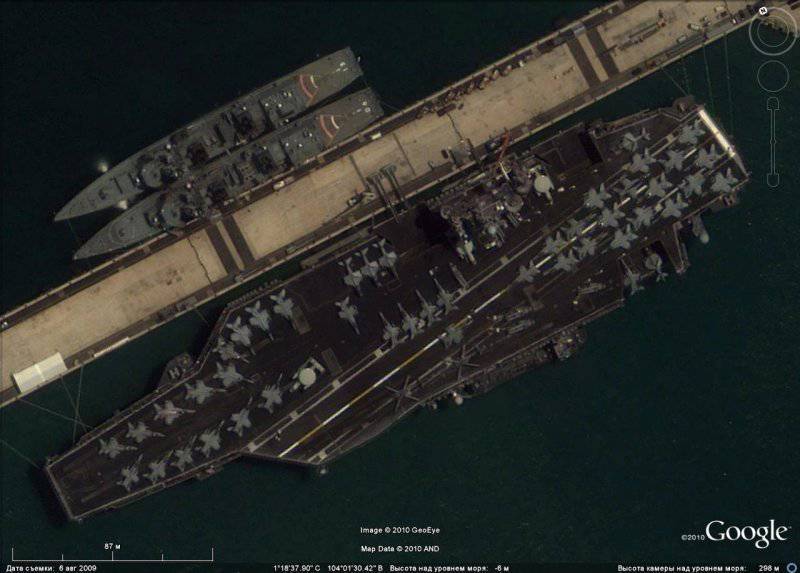
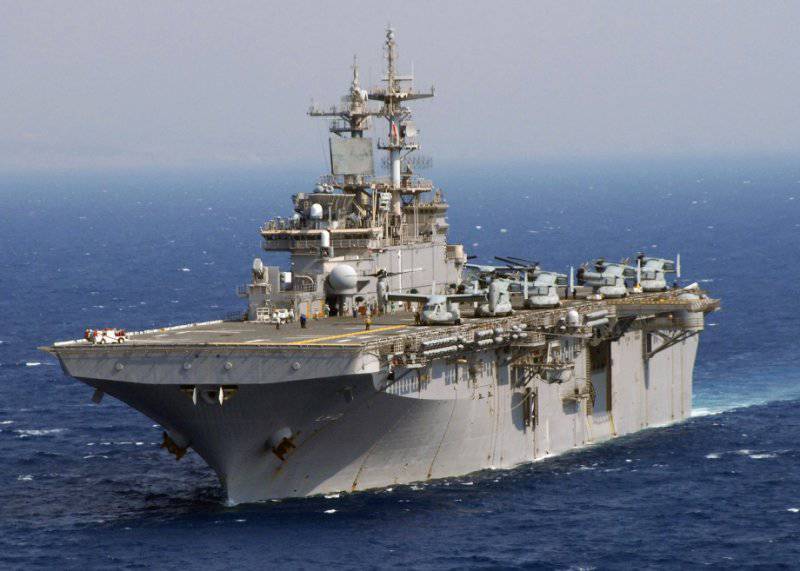
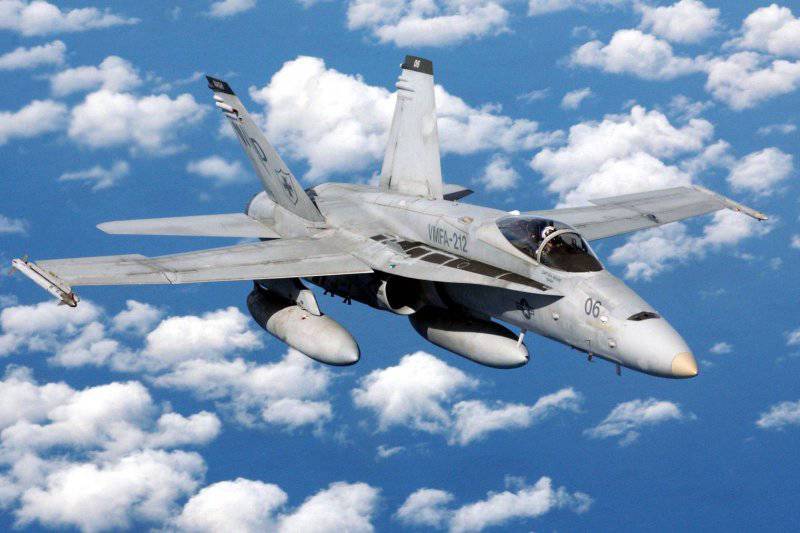
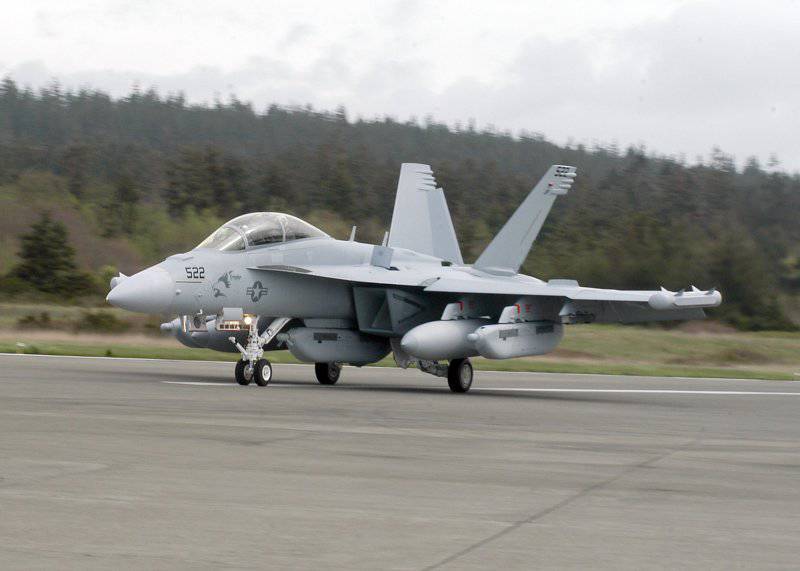
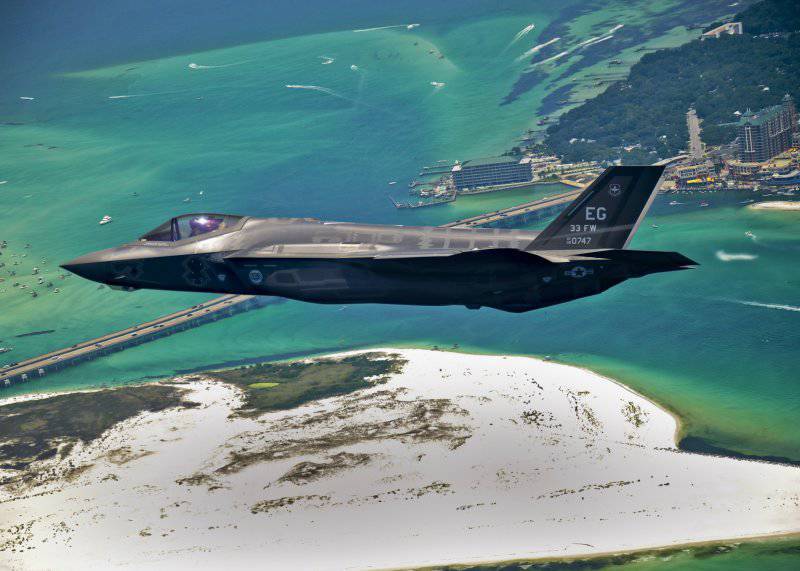
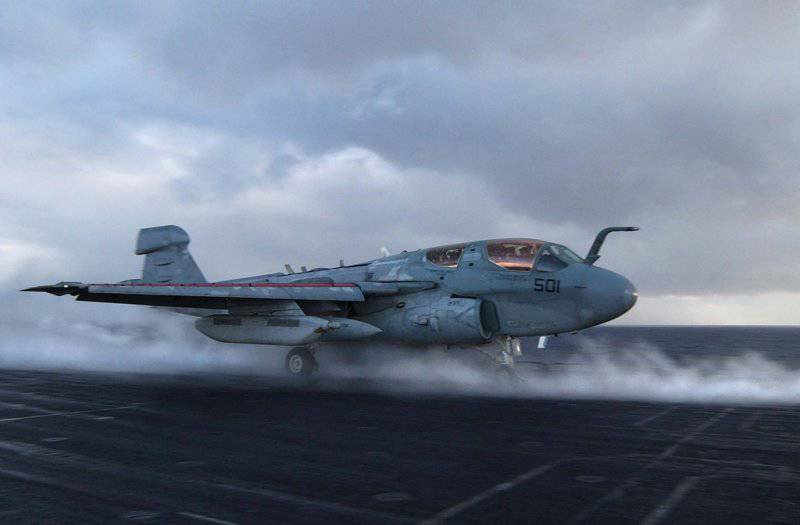
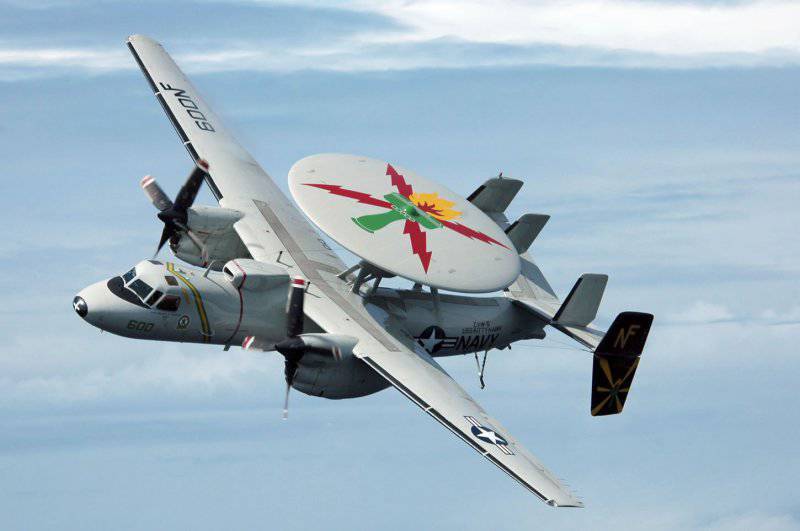
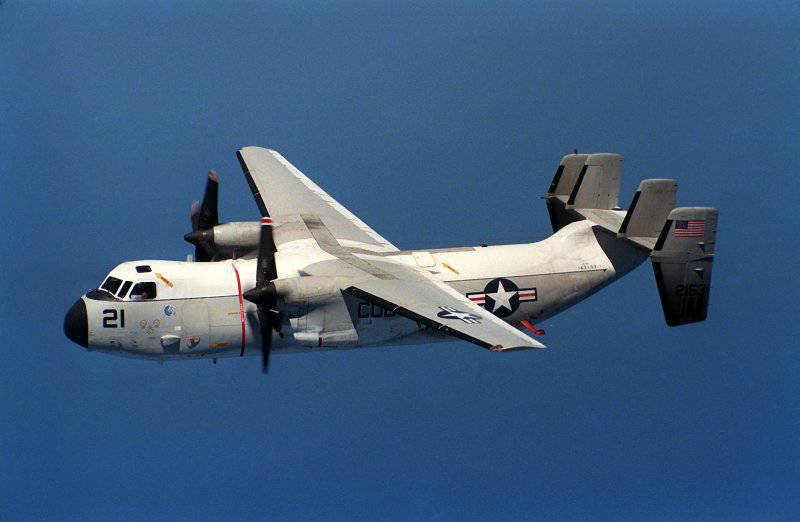
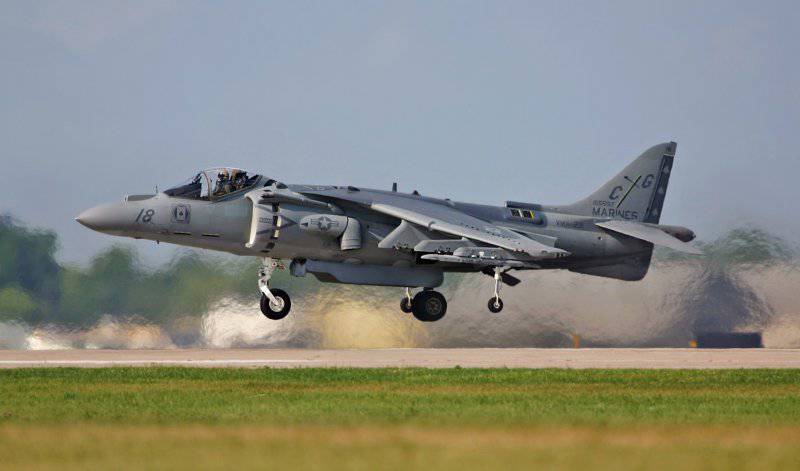
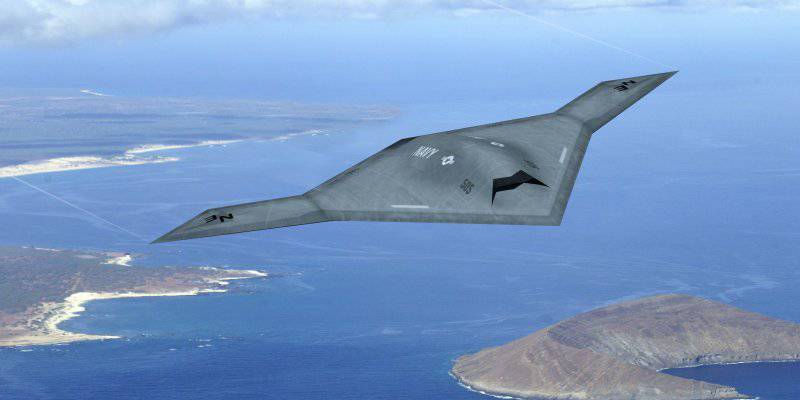
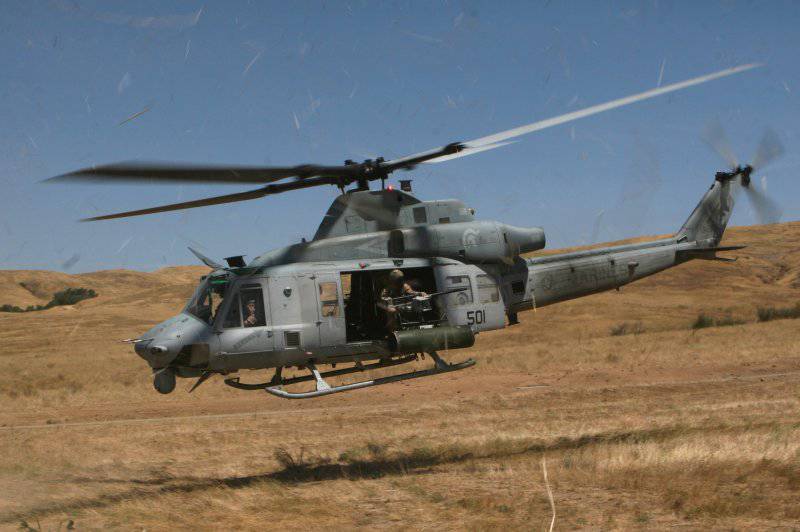
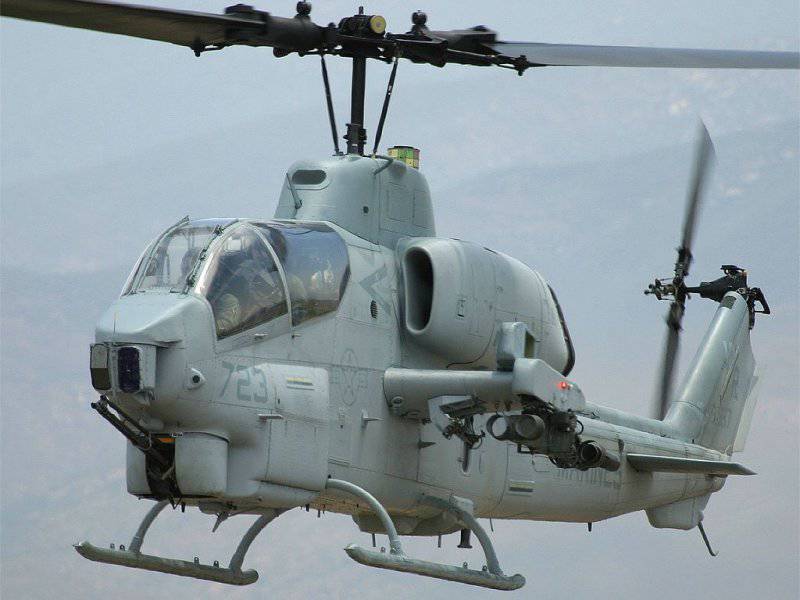
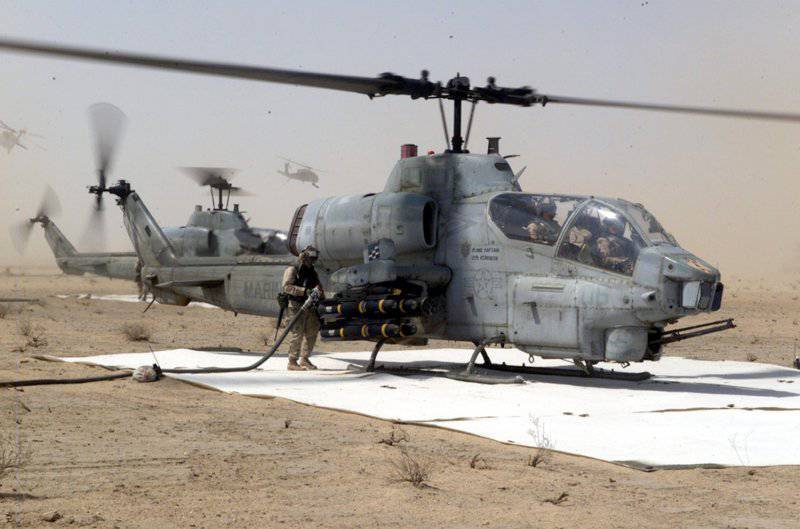
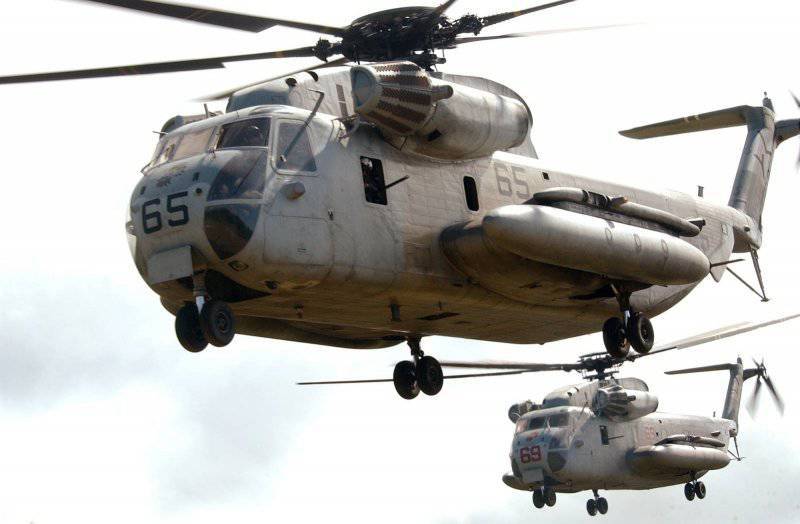
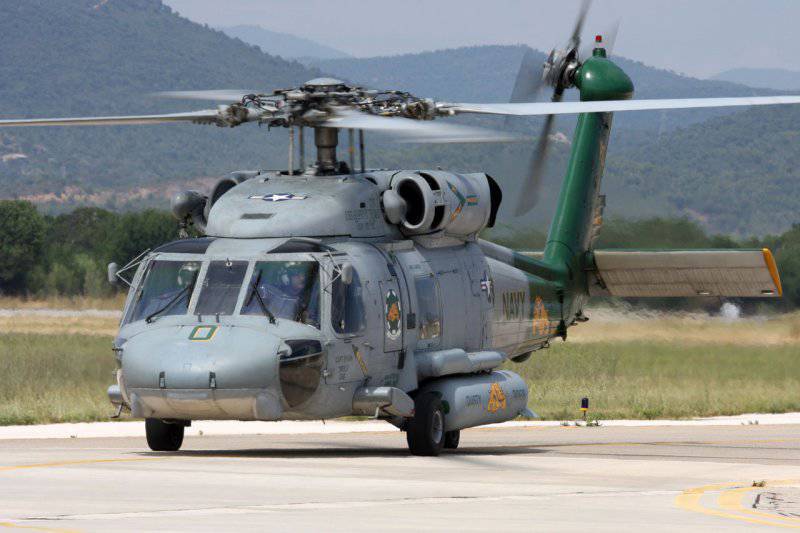
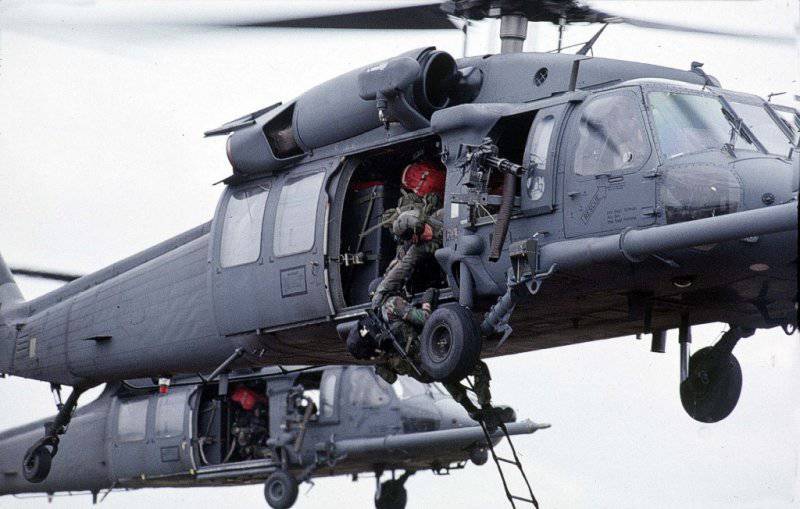
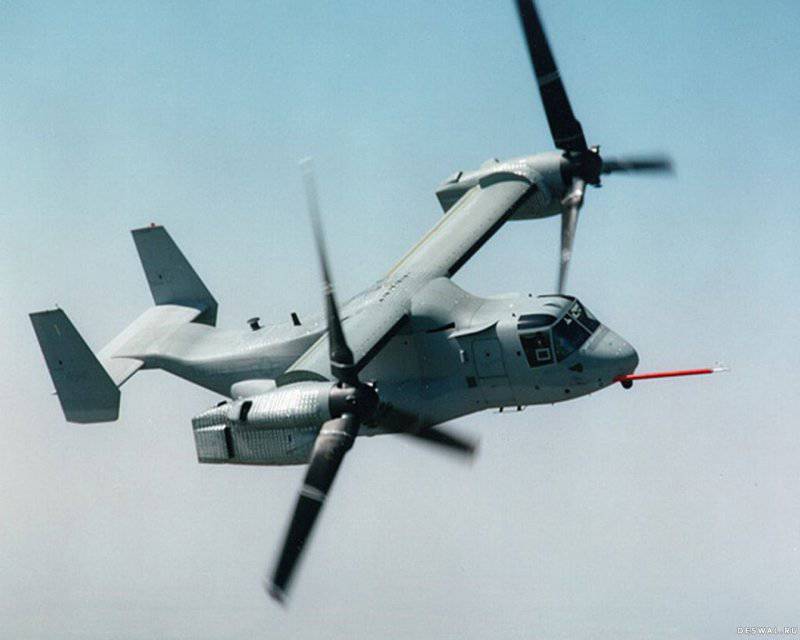
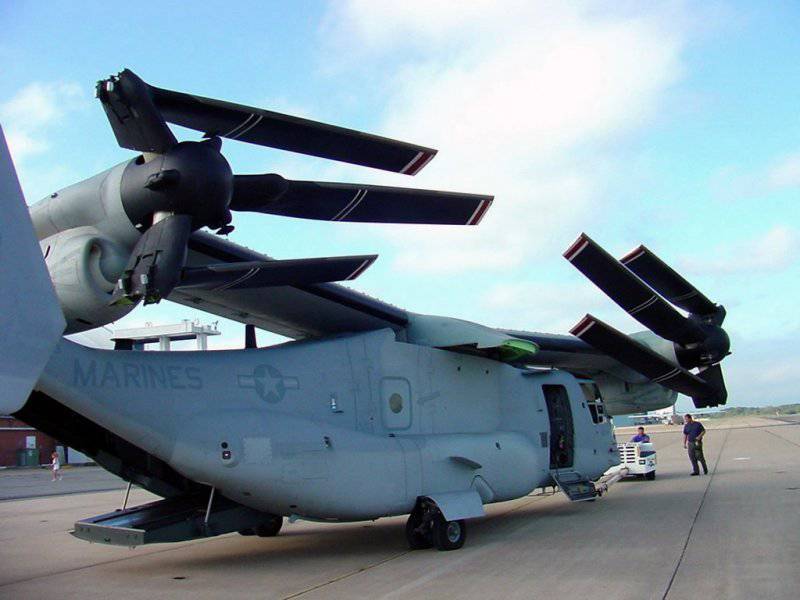
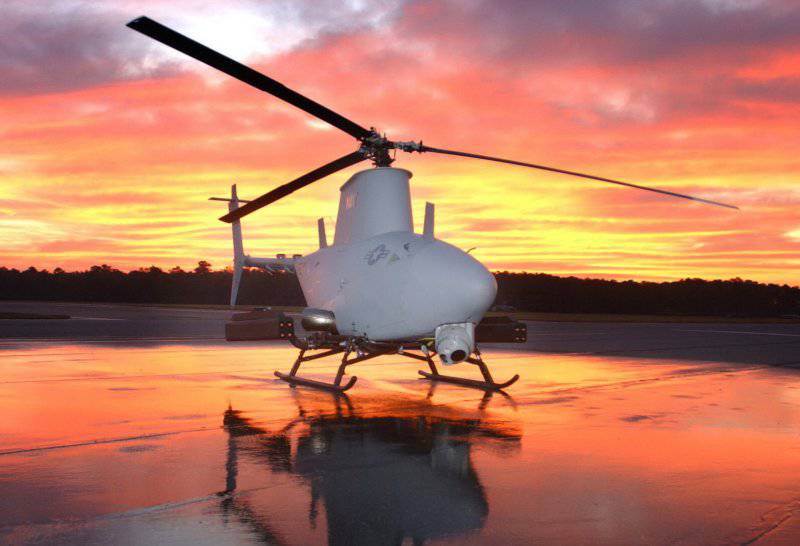
Information